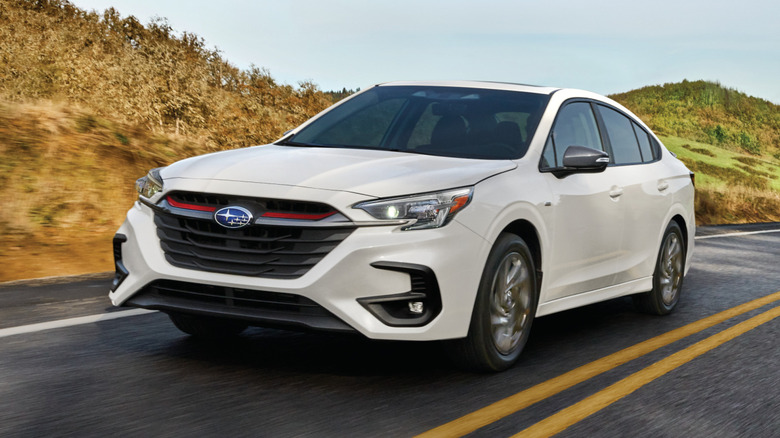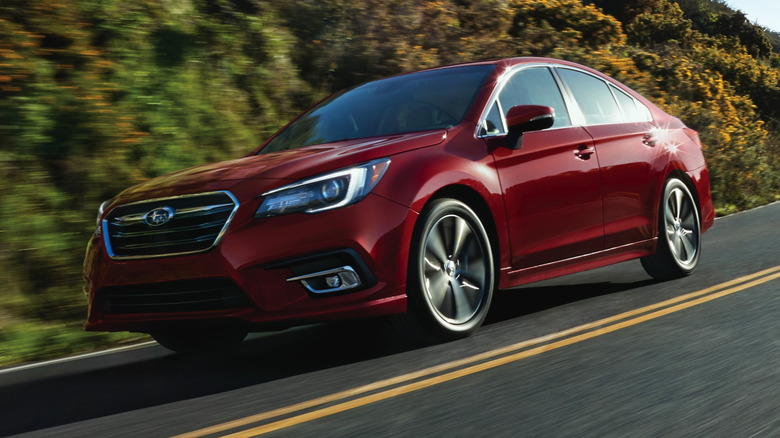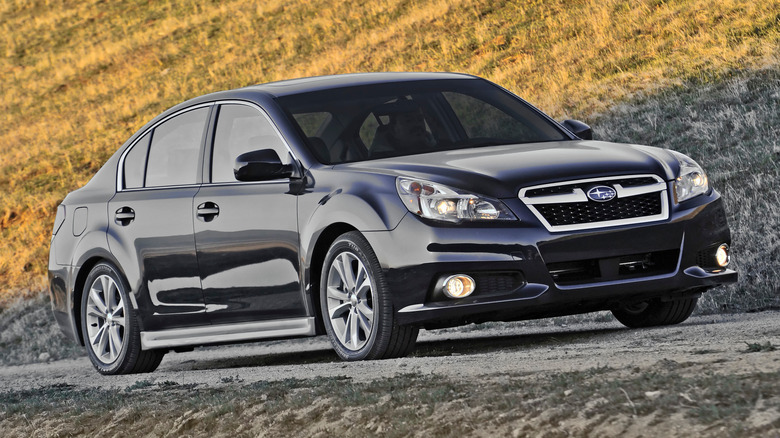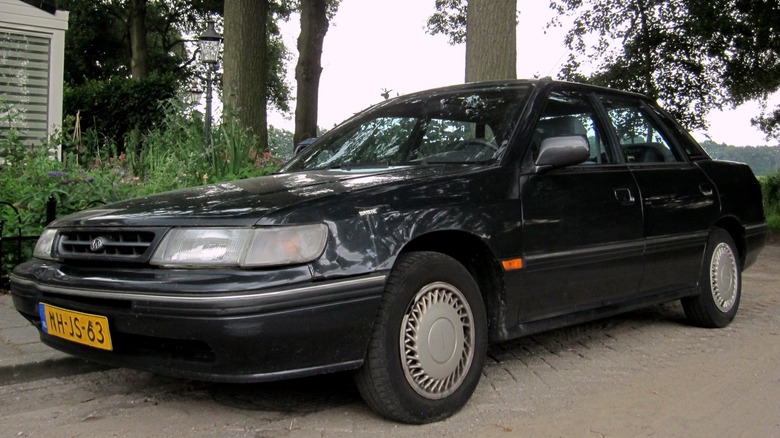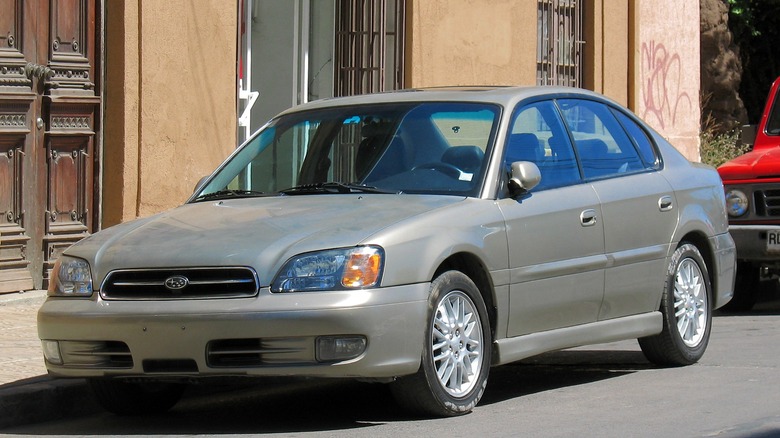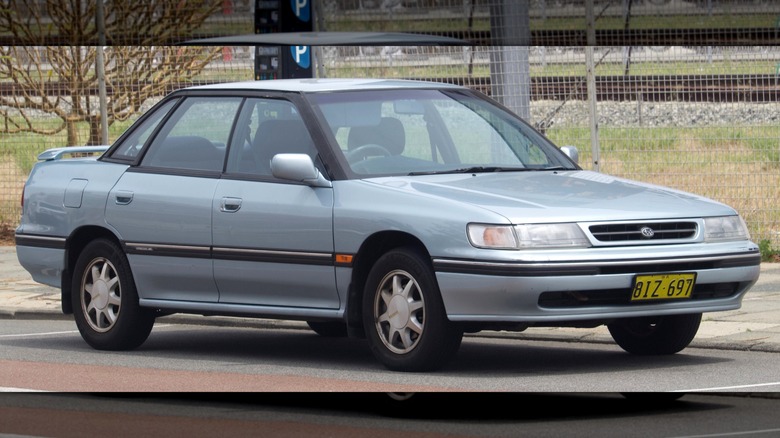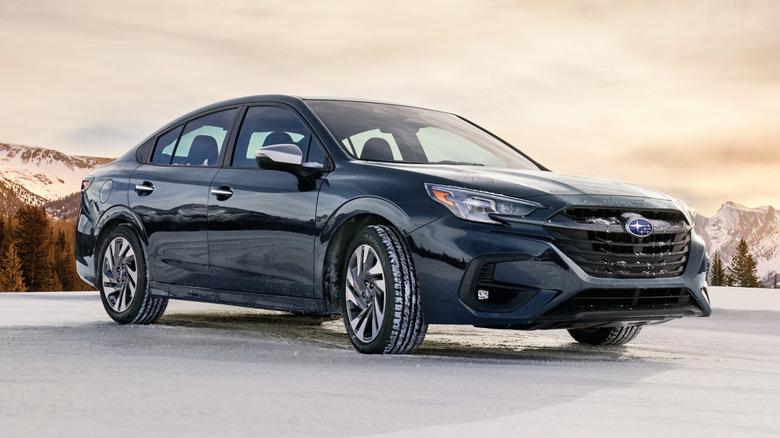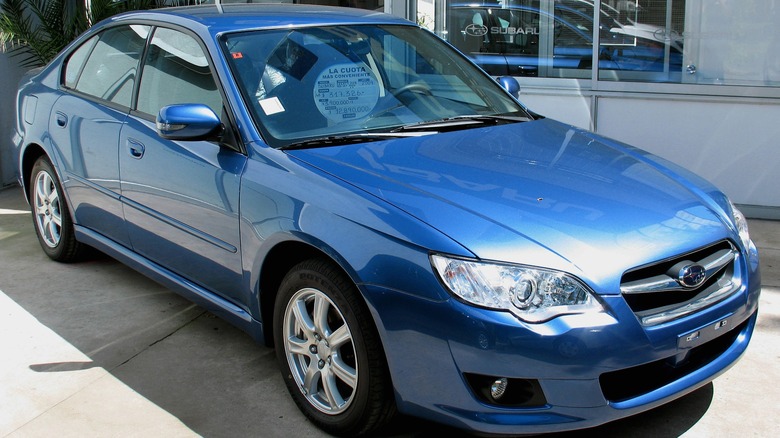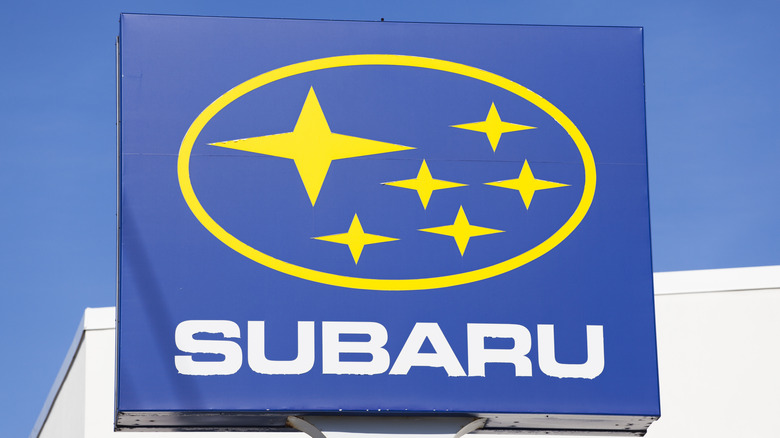Every Generation Of The Subaru Legacy, Ranked Least To Most Reliable
We may receive a commission on purchases made from links.
Mention Subaru, and many petrolheads will likely think of the Mitsubishi rivaling the Impreza WRX. While the WRX certainly helped raise Subaru's profile in the rallying world, it's cars like the four-door Legacy that helped establish the brand in the West. As the first U.S.-built Subaru, the Legacy debuted in 1989 and was a massive departure from Subaru's prior offerings, many of which were small and surprisingly quirky. Case in point — the cult-classic Subaru BRAT.
The 1989 Legacy was Subaru's largest and most powerful car up until then, designed to compete with sedans from rival Japanese manufacturers Toyota and Honda. Compete it did, quickly becoming a best-seller wherever the company sold it. The Legacy continued for another seven generations after debuting, selling well above 1 million units in the U.S. alone.
It's not hard to see why, as the Legacy has always been one of the most reliable Subaru models ever built, as the numbers back it up, too. Even the worst model years max out at around 200 complaints on the NHTSA website, placing it firmly in the tradition of dependable cars like the Toyota Camry. However, even the best car has some less-reliable years, so we've gone through owner complaints and recalls on the NHTSA website — check out the end of our article for a more in-depth explanation — to rank all seven of the Legacy's generations in order of reliability.
Whether you're in the market for a Legacy or are just curious where yours ranks in the model's 30-plus-year history, we've got you covered.
Sixth generation (2015 - 2019)
Subaru opted to go all-CVT when it launched the 2015 Legacy, dropping manual transmissions in favor of the CVT's better fuel efficiency. The 3.6-liter engine received a slightly more durable CVT to accommodate its extra torque, but overall, the tale was the same: efficiency over tradition. Other improvements included a nicer, better-appointed interior, stiffer chassis, and revised suspension.
Unfortunately, the sixth generation seems to have brought with it a range of new problems, some of which seem quite dangerous. However, let's start with the less troubling issues. Firstly, the windscreen is allegedly quite prone to cracking and chipping, with owners reporting damaged glass even from minor impacts (or, in some cases, without any perceptible impact). Subaru and its dealers don't always seem helpful here, either, so you'd better get familiar with using products like RainX's Windshield Repair Kit if you purchase a sixth-gen Legacy.
But sensitive windscreens are the least of this generation's worries. This generation also seems to have a bad parasitic battery drain problem, allegedly bad enough to require daily driving to keep the battery charged. Furthermore, this whole generation allegedly suffers from the unintended acceleration issue, although this particular problem is a point of contention. Owners blame Subaru, Subaru blames the drivers, and it seems like a mess you're best not getting involved in if possible. Life-threatening Takata airbags aren't an issue, at least, although that may prove scant comfort if you fall victim to a randomly accelerating Legacy.
Fifth generation (2010 - 2014)
Subaru unveiled the fifth-generation Legacy at the 2009 New York Auto Show with a bevy of updates: a slightly longer wheelbase, revamped interior, new design cues, and new powertrains. The updated Legacy now came with a 170 hp, 2.5-liter flat four as standard, with the Legacy 2.5GT sporting an Impreza WRX-derived 265 hp power plant under the hood. Both options offered either a six-speed manual or, in a first for the Legacy, Subaru's then-new Lineartronic CVT.
CVTs don't have the best reputation, and Subaru's offering lived up to some common beliefs about CVT unreliability, at least for the first few years. CVT-related complaints on the NHTSA website started almost from the get-go, with owners of the 2010 model noting that it tended to stall under braking and when slowing down. The issue mostly seemed present until 2012, after which stalling complaints died down. This isn't to say that the final two years are completely trouble-free — a handful of 2013 Legacy owners had to deal with CVT component failures — but Subaru seems to have eventually figured it out.
The fifth-gen Legacy's other main problem is the potentially fatal Takata airbags, which Subaru used throughout this generation. Despite the severity of the issue, many owners faced trouble getting their cars looked at and addressed. One owner, for example, had waited four years for replacement airbags as of 2022. So, if you're after a fifth-gen Legacy, try and get one that's had its airbags replaced — lest you inherit the previous owner's headache.
Second generation (1995 - 1999)
After the first-gen became a big hit, it wasn't much of a surprise when the Japanese manufacturer brought the second-generation Legacy to North America in 1995. In what would become a trend with each successive generation, the updated Legacy brought with it a nicer interior and stiffer, uprated suspension, although the mid-'90s Legacy dropped the turbo present on the first-gen.
Subaru also got rid of the motorized seatbelts from the first generation, eliminating them as a potential issue for modern-day buyers. Another ostensible improvement, the standard dual airbags, seems to have been much less of a positive. The airbags were the most commonly complained-about aspect of the early second-generation Legacy models, generally involving overly sensitive deployment. The tow hook seems to be the culprit, with owners claiming that the airbags deploy when the tow hook contacts the ground.
Other faults present across this generation include failure-prone head gaskets that sometimes blow while driving, oil leaks from various areas of the engine, brake failures, and the occasional slipping transmission. Age won't have helped any of these issues, either, and you'll likely need to do some extensive drivetrain checks before buying one.
To be fair, none of these issues are distressingly common, especially compared to other cars from other brands (the 2011 Hyundai Sonata and its terrible engine come to mind). However, the total package of potential faults makes the second-gen Legacy perhaps slightly less appealing than the generations immediately before and after.
[Image by Rutger van der Maar via Wikimedia Commons | Cropped and scaled | CC BY 2.0]
Third generation (2000 - 2004)
Subaru ushered in the new millennium with a new Legacy, debuting the third generation of its popular four-door in 2000. Subaru continued tweaking and improving the Legacy, with the seemingly requisite chassis and suspension upgrades further endearing it to reviewers — although some also wished for more power than the 165 hp that the standard 2.5-liter boxer engine provided.
The 2.5-liter engine was the same as in the second generation, albeit with slightly more torque — 166 lb-ft compared to 162 lb-ft — and a wider torque curve. However, this meant the engine had the same problems with head gaskets. These seem quite failure-prone, with one owner replacing head gaskets three times within 100,000 miles. A few owners claim that Subaru's suggested fix was pouring a stop leak fluid into the coolant, so if you opt for one of these Legacy models, having a bottle of Bar's Leaks 1186 Liquid Aluminum Stop Leak on hand may be a good idea.
All four model years were also part of a recall for a leak-prone fuel pump, making that component a vital one to check — or have a service history for — if you're buying a used third-gen Legacy. You'll also want to be cautious when looking at 2003 and 2004 Legacy models, as these could have defective Takata airbags. Given all the delays and difficulties brands have encountered trying to fix affected cars, we recommend you steer clear from any third-gen Legacy models that haven't been repaired.
[Image by order_242 via Wikimedia Commons | Cropped and scaled | CC BY-SA 2.0]
First generation (1989 - 1994)
Subaru's first-generation Legacy set the stage for the next 30-odd years of reliability, with even these early-1990s cars not exhibiting any notoriously deal-breaking issues. Are they totally trouble-free? No, of course not, but the problems with these — at least, based on owner complaints on the NHTSA website — are far from the nightmare that old cars can sometimes be.
The most widespread issue across the Legacy's initial five-year run involves the seat belts. The motorized seat belts tend to fail one way or another, sometimes by jamming in the middle of the travel or slipping off the track. Both situations render the seat belt essentially useless, so you'd best have a plan to address it if you want to get one of these. Some owners also complained that the lap belts eventually fall apart – not ideal, even 10 years after the fact, but also perhaps not the most damning fault the NHTSA's logged on its website.
Owners of 1991 and newer first-gen Legacy models also sporadically complain of the engine randomly stalling and cutting out while driving. It's not widespread enough to indicate a fundamental flaw with the engine, but it's a good reminder that you should have the engine checked by a mechanic before buying any 30-year-old car on Facebook Marketplace or another third party. One more tidbit to be aware of is that Subaru recalled 1990 to 1993 Legacy models for automatic and manual transmission issues, so you'll want to check the transmission thoroughly on a test drive as well.
[Image by EurovisionNim via Wikimedia Commons | Cropped and scaled | CC BY-SA 4.0]
Seventh generation (2020 - 2025)
The newest generation of the Subaru Legacy is also going to be its last, and Subaru seems so far to be going out on a decent note as far as reliability goes. Now, to be clear, the seventh-generation Legacy, which debuted for the 2020 model year, isn't without its faults. However, the signs are positive that it'll be another solid generation of a perennially solid and sensible car with above-average reliability, based on SlashGear's behind the wheel review.
Out of all the currently available seventh-generation Legacy models, the 2020 model is perhaps the only one we'd suggest you exercise caution before buying — primarily because of the alleged unintended acceleration problem. It's not necessarily widespread, at least if we're going by complaints the NHTSA has collected. However, reports do make for uneasy reading, even if Subaru insists that driver error is behind all the claims. Not necessarily a hard avoid, then, but something to bear in mind.
Fragile windscreens are another fault that continues from the previous generation, with the majority of complaints about the relatively fresh 2022 Legacy involving damaged windscreens. Like on the sixth-gen Legacy, owners claim that the windscreen develops cracks from minor impacts, and some even maintain that the glass develops cracks on its own. The only other notable concern is a fault in the airbag sensor circuitry that prevents the front passenger airbag from deploying. The problem is present in 2020 to 2022 Legacy and Outback models, and Subaru has recalled nearly 119,000 cars as of March 2024.
Fourth generation (2005 - 2009)
Is a deadly airbag recall a reliability issue? That's the million-dollar question when we talk about the fourth-generation Legacy. While this whole generation of Legacy models is affected by these dangerous airbags, the rest of the car seems to be one of the more reliable generations in the Legacy's history.
Of course, that doesn't mean that the fourth-generation Legacy — which debuted in 2005 and marked the return of a turbo to the nameplate — is perfect. That turbo, for example, seems to have been prone to failing on 2005 models, with more than a few owners claiming blown and damaged turbochargers. The issue allegedly stems from an oil starvation issue, which the company outlined in a 2007 service bulletin. Unfortunately, the only solution seems to have been regular oil and filter changes, with the company recommending owners do so every 3,750 miles.
Interestingly, turbo-related complaints on the NHTSA website dropped significantly after the first two model years, perhaps indicating that dealerships and service centers were now changing oil according to Subaru's recommendation. So, you'll want to get a fourth-gen Legacy with a good service history to avoid any turbo-related pains in the long run. Beyond that and a recalled-for brake line corrosion issue — and the Takata airbags, of course – the fourth-gen Legacy seems to be one of the best. It's a solid place to start looking if you want a sensible four-door for around $4,000, according to Kelley Blue Book's Fair Purchase Price.
[Image by RL GNZLZ via Wikimedia Commons | Cropped and scaled | CC BY-SA 2.0]
Our selection methodology
The primary source for our ranking of Subaru Legacy generations is the NHTSA website, which tracks owner complaints, recalls, and investigations for cars sold in the U.S. Specifically, we based our judgments of each Subaru Legacy generation based on the number of owner complaints for the model years within each generation — not necessarily the perfect way to evaluate, admittedly, but one that proves quite useful. However, it's not just the number of complaints. Some issues, such as engine and drivetrain problems, are much more serious and expensive to fix than minor issues such as iffy power window regulators, and so they rank higher here.
Recalls also influence our evaluations, as there's not always a guarantee that a car's previous owner(s) will have sent it in to fix any recalled-for issues. There's also the all-too-common possibility that a part fixed under recall has failed again, as we've seen in many other instances. Given the generational focus of this list, we didn't have space to dig too deeply into recalled issues for specific model years, but we tried to highlight any major recalls to give you an idea of what to look out for.
As always, make sure any car you're interested in has had any necessary recall-related work done before buying it. This won't necessarily guarantee trouble-free ownership, but it should at least tilt things in your favor.
